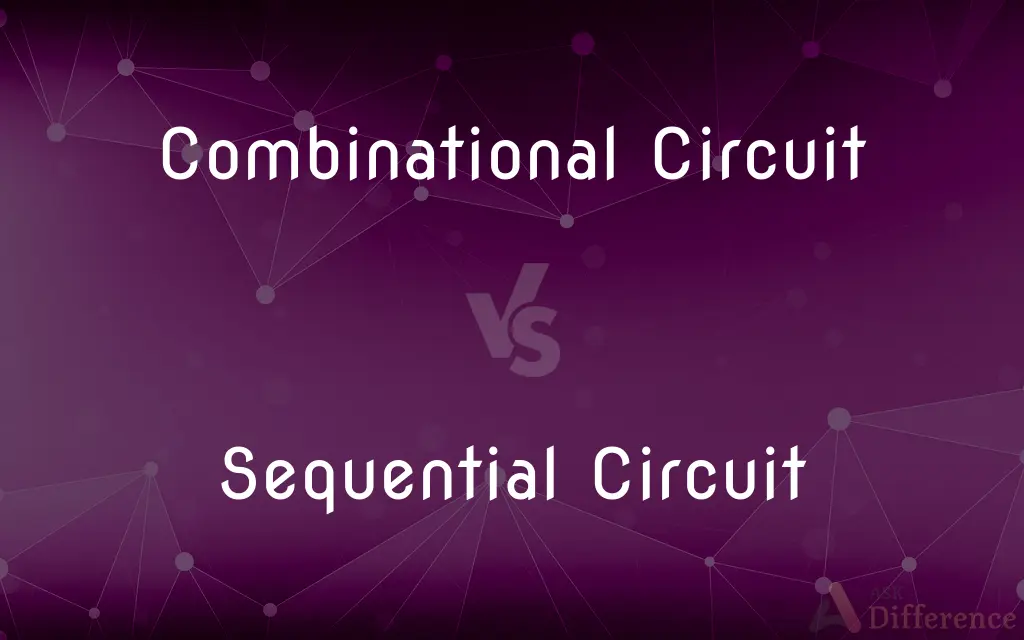Combinational Circuit vs. Sequential Circuit — What's the Difference?
By Tayyaba Rehman — Published on December 8, 2023
Combinational circuits output only depend on current inputs, while sequential circuits' output depends on current inputs and previous states.

Difference Between Combinational Circuit and Sequential Circuit
Table of Contents
ADVERTISEMENT
Key Differences
Combinational circuits are a type of digital circuit where the output is determined solely by its current inputs. On the other hand, sequential circuits produce outputs based on both current inputs and previous input-output sequences.
In a combinational circuit, there's no concept of memory or feedback. However, in sequential circuits, memory elements like flip-flops store past information, affecting future outputs.
Combinational circuits, being memoryless, are generally faster in operation. Sequential circuits, with their memory components, can have delays due to storage and retrieval of past states.
Examples of combinational circuits include adders, subtractors, and multiplexers. Sequential circuits, conversely, find applications in devices like registers, counters, and memory units.
Comparison Chart
Dependence on
Current inputs only
Current inputs and previous states
ADVERTISEMENT
Memory Components
None
Contains memory elements like flip-flops
Operation Speed
Generally faster
Can have delays due to memory operations
Examples
Adders, subtractors
Registers, counters, memory units
Feedback/Memory
Absent
Present
Compare with Definitions
Combinational Circuit
Lacks memory components.
The logic gate design was purely a combinational circuit without memory.
Sequential Circuit
Contains memory elements to store previous states.
Flip-flops in the design indicated it was a sequential circuit.
Combinational Circuit
No feedback loop present.
Without any feedback mechanism, the design was a simple combinational circuit.
Sequential Circuit
Has feedback loops to store and retrieve information.
The presence of feedback loops classifies this as a sequential circuit.
Combinational Circuit
Often used in arithmetic logic units.
The ALU had multiple combinational circuits for mathematical operations.
Sequential Circuit
Digital circuit with outputs based on current and past inputs.
The counter is a typical example of a sequential circuit.
Combinational Circuit
A digital circuit with outputs based only on current inputs.
In this project, the adder is a basic combinational circuit.
Sequential Circuit
Can introduce delays due to memory operations.
Because it's a sequential circuit, there's a small delay before getting the output.
Combinational Circuit
Produces instantaneous output for given inputs.
The combinational circuit produced results as soon as the inputs were provided.
Sequential Circuit
Essential for designing memory units and registers.
The device's memory was built using various sequential circuits.
Common Curiosities
Can you provide an example of a combinational circuit?
Yes, an adder or a subtractor is an example of a combinational circuit.
Which circuit can have delays due to memory operations?
Sequential circuits can introduce delays because of memory operations.
Which circuit type depends solely on current inputs?
Combinational circuits depend only on current inputs.
Do sequential circuits have memory components?
Yes, sequential circuits contain memory elements like flip-flops.
Can sequential circuits be used for arithmetic operations?
While they can be part of broader systems for arithmetic, basic arithmetic operations are typically combinational.
Are logic gates considered combinational or sequential?
Basic logic gates are combinational circuits.
Are multiplexers combinational or sequential circuits?
Multiplexers are combinational circuits.
Can a circuit be both combinational and sequential?
A complex system might use both types, but individual circuits are typically one or the other.
What makes sequential circuits different from combinational ones?
The key difference is that sequential circuits have memory components and rely on past states, while combinational circuits do not.
Why don't combinational circuits have feedback loops?
Because they don't store information or states, hence no feedback is needed.
What is the main application of sequential circuits?
They are used in devices like registers, counters, and memory units.
Which circuit is generally faster in operation?
Combinational circuits are generally faster since they lack memory operations.
In which circuit type is the past state important?
In sequential circuits, past states are important for determining outputs.
Do combinational circuits have flip-flops?
No, flip-flops are memory elements used in sequential circuits.
What dictates the output of a sequential circuit?
Both current inputs and previous input-output sequences dictate the output.
Share Your Discovery

Previous Comparison
Bonding Molecular Orbitals vs. Antibonding Molecular Orbitals
Next Comparison
Aquaculture vs. FisheriesAuthor Spotlight
Written by
Tayyaba RehmanTayyaba Rehman is a distinguished writer, currently serving as a primary contributor to askdifference.com. As a researcher in semantics and etymology, Tayyaba's passion for the complexity of languages and their distinctions has found a perfect home on the platform. Tayyaba delves into the intricacies of language, distinguishing between commonly confused words and phrases, thereby providing clarity for readers worldwide.
















































